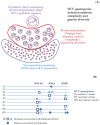The Role of RASs /RVs in the Current Management of HCV
- PMID: 34696525
- PMCID: PMC8539246
- DOI: 10.3390/v13102096
The Role of RASs /RVs in the Current Management of HCV
Abstract
The approval of combination therapies with direct-acting antiviral (DAA) regimens has led to significant progress in the field of hepatitis C virus (HCV) treatment. Although most patients treated with these agents achieve a virological cure, resistance to DAAs is a major issue. The rapid emergence of resistance-associated substitutions (RASs), in particular in the context of incomplete drug pressure, has an impact on sustained virological response (SVR) rates. Several RASs in NS3, NS5A and NS5B have been linked with reduced susceptibility to DAAs. RAS vary based on HCV characteristics and the different drug classes. DAA-resistant HCV variant haplotypes (RVs) are dominant in cases of virological failure. Viruses with resistance to NS3-4A protease inhibitors are only detected in the peripheral blood in a time frame ranging from weeks to months following completion of treatment, whereas NS5A inhibitor-resistant viruses may persist for years. Novel agents have been developed that demonstrate promising results in DAA-experienced patients. The recent approval of broad-spectrum drug combinations with a high genetic barrier to resistance and antiviral potency may overcome the problem of resistance.
Keywords: DAA; HCV; RAS; viral resistance.
Conflict of interest statement
The authors declare no conflict of interest.
Figures



References
-
- Farci P., Wollenberg K., Diaz G., Engle R.E., Lai M.E., Klenerman P., Purcell R.H., Pybus O.G., Alter H.J. Profibrogenic chemokines and viral evolution predict rapid progression of hepatitis C to cirrhosis. Proc. Natl. Acad. Sci. USA. 2012;109:14562–14567. doi: 10.1073/pnas.1210592109. - DOI - PMC - PubMed
Publication types
MeSH terms
Substances
LinkOut - more resources
Full Text Sources
Medical

